The aquaculture prebiotics market is projected to grow from USD 1,234.2 million in 2025 to USD 2,220.1 million by 2035, recording an absolute increase of USD 985.9 million over the forecast period. This translates into a total growth of 79.9%, with the market forecast to expand at a compound annual growth rate (CAGR) of 6.0% between 2025 and 2035. The overall market size is expected to grow by nearly 1.8X during the same period, supported by increasing demand for efficient gut health management systems, rising adoption of precision aquaculture technologies, and growing focus on antibiotic-free production methods across the global fish farming and marine aquaculture sectors.
Mannan-oligosaccharides (MOS) account for the largest share at 25.0% due to proven pathogen binding capabilities, immune system enhancement, and compatibility with existing feed formulations, while plant-derived sources represent 35.0% of the market through natural ingredient demand. Shrimp applications represent the dominant share at 35.0% of demand, followed by freshwater fish as farmers expand production while managing disease pressure.
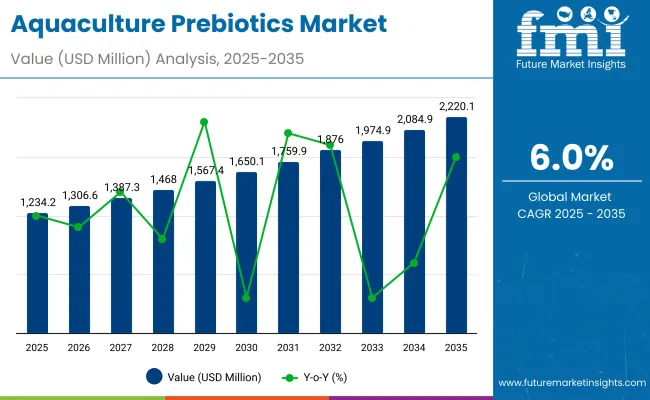
Aquaculture Prebiotics Market Key Takeaways
| Metric | Value |
|---|---|
| Estimated Value in (2025E) | USD 1,234.2 million |
| Forecast Value in (2035F) | USD 2,220.1 million |
| Forecast CAGR (2025 to 2035) | 6.0% |
Europe leads regional growth, with France (6.9% CAGR) and Germany (6.4% CAGR) driven by aquaculture modernization and regulatory compliance, while Asia Pacific shows strong expansion supported by China and India's expanding fish farming operations. Competition in the aquaculture prebiotics market remains moderately consolidated, with key companies such as Alltech Inc. (18.0% share), Nutreco N.V., and Cargill Aqua Nutrition focusing on fermentation technologies, species-specific formulations, and technical support capabilities to strengthen market positioning.
The market dynamics driving aquaculture prebiotic adoption are fundamentally shaped by escalating disease management concerns, regulatory pressures for antibiotic reduction, and the aquaculture industry's transformation toward precision nutrition methodologies. Climate change has intensified pathogen pressure and water quality challenges across major aquaculture regions, compelling fish farmers and shrimp producers to implement more sophisticated health management strategies. Simultaneously, government regulations and consumer demands in many jurisdictions increasingly incentivize antibiotic-free production through certification programs, export requirements, and premium pricing mechanisms that make prebiotic feed additives economically attractive investments.
Technological advancement in microbiology research, fermentation technology, and feed processing platforms has dramatically enhanced the capabilities and accessibility of prebiotic feed systems. Modern prebiotics leverage advanced oligosaccharide structures, encapsulation technologies, and synbiotic combinations to provide targeted gut microbiome support and immune system enhancement from any production facility, enabling immediate response to changing health conditions and proactive disease management. The integration of species-specific formulations, water quality monitoring, growth performance analytics, and predictive health modeling enables these systems to optimize feeding protocols based on actual physiological needs rather than predetermined schedules, resulting in significant feed conversion improvements and enhanced survival rates.
The aquaculture sector's increasing adoption of precision farming technologies has created substantial demand for integrated nutrition management solutions that complement existing farm management systems. Aquaculture prebiotics now interface seamlessly with feed management software, enabling comprehensive data collection and analysis that supports broader production decision-making processes. This integration capability has proven particularly valuable for large-scale commercial aquaculture operations where coordinated management of multiple production ponds and species types requires sophisticated nutrition and health monitoring capabilities.
Between 2025 and 2030, the aquaculture prebiotics market is projected to expand from USD 1,234.2 million to USD 1,650.1 million, resulting in a value increase of USD 415.9 million, which represents 42.2% of the total forecast growth for the decade. This phase of development will be shaped by rising demand for gut health management systems, increasing applications in precision aquaculture and smart farming technologies, and growing penetration in emerging fish farming automation markets. Feed additive manufacturers are expanding their production capabilities to address the growing demand for customized prebiotic formulations in various aquaculture segments and species-specific nutrition programs.
From 2030 to 2035, the market is forecast to grow from USD 1,650.1 million to USD 2,220.1 million, adding another USD 570.0 million, which constitutes 57.8% of the overall ten-year expansion. This period is expected to be characterized by the expansion of advanced aquaculture nutrition infrastructure, the integration of cutting-edge fermentation technologies, and the development of customized prebiotic systems for specific species applications. The growing adoption of precision aquaculture standards and automated feeding systems will drive demand for ultra-high efficiency prebiotics with enhanced bioavailability specifications and consistent performance characteristics.
Between 2020 and 2025, the aquaculture prebiotics market experienced steady expansion, driven by increasing recognition of gut health solutions' importance in fish health management operations and growing acceptance of functional feed additives in complex aquaculture markets. The market developed as farmers recognized the need for high-efficiency health management systems to address production requirements and improve overall operational productivity. Research and development activities have begun to emphasize the importance of advanced oligosaccharide technologies in achieving better growth performance and health outcomes in aquaculture processes.
Market expansion is being supported by the increasing demand for antibiotic-free aquaculture production infrastructure and the corresponding need for high-efficiency prebiotic systems in fish farming applications across global aquaculture and marine farming operations. Modern aquaculture operators are increasingly focused on advanced nutrition technologies that can improve operational efficiency, reduce disease incidence, and enhance growth performance while meeting stringent food safety requirements. The proven efficacy of prebiotics in various aquaculture applications makes them an essential component of comprehensive health management strategies and farm modernization programs.
The growing emphasis on precision aquaculture and advanced gut health optimization is driving demand for ultra-efficient prebiotic systems that meet stringent performance specifications and regulatory requirements for specialized applications. Aquaculture operators' preference for reliable, high-performance nutrition systems that can ensure consistent health outcomes is creating opportunities for innovative fermentation technologies and customized species solutions. The rising influence of organic certification protocols and antibiotic reduction standards is also contributing to increased adoption of premium-grade prebiotics across different aquaculture applications and feeding systems requiring advanced nutrition technology.
The aquaculture prebiotics market represents a specialized growth opportunity, expanding from USD 1,234.2 million in 2025 to USD 2,220.1 million by 2035 at a 6.0% CAGR. As farmers prioritize operational efficiency, disease prevention, and growth performance in complex aquaculture processes, prebiotics have evolved from a niche feed additive technology to an essential component enabling health management, nutrition optimization, and multi-stage aquaculture production across farming operations and specialized feeding applications.
The convergence of aquaculture expansion, increasing automation adoption, specialized nutrition infrastructure growth, and regulatory requirements creates momentum in demand. High-efficiency formulations offering superior gut health performance, cost-effective MOS systems balancing performance with economics, and specialized marine-derived variants for premium applications will capture market premiums, while geographic expansion into high-growth Asian aquaculture markets and emerging market penetration will drive volume leadership. Aquaculture emphasis on efficiency and performance provides structural support.
The market is segmented by prebiotic type, source, application, form, functionality, and distribution channel, and region. By prebiotic type, the market is divided into mannan-oligosaccharides (MOS), fructo-oligosaccharides (FOS), galacto-oligosaccharides (GOS), inulin, beta-glucans, resistant starch and fibers, and novel prebiotics such as algal polysaccharides, yeast cell wall derivatives, and chitosan oligosaccharides. Based on source, the market is classified into plant-derived ingredients including chicory root, cereals, legumes, and tubers; yeast and fungal-derived sources such as Saccharomyces and cell wall extracts; algal and marine-derived materials like seaweed extracts and oligosaccharides; and synthetic or fermentation-derived variants.
By application, the market is segmented into shrimp, freshwater fish (tilapia, carp, catfish), marine fish (salmon, seabass, grouper), mollusks (oysters, clams, mussels), and others including crabs, ornamental fish, and emerging species. Based on form, the market is categorized into powder or dry blends, liquid additives, encapsulated or coated forms, and prebiotic-rich functional feed.
By functionality, the market is segmented into gut health and microbiome balance, growth performance and feed conversion, immunity enhancement and disease resistance, and stress tolerance under conditions such as salinity, crowding, and transport. In terms of distribution channel, the market is divided into direct-to-feed mills and integrators, distributors or wholesalers, and online and specialized aquaculture suppliers. Regionally, it spans North America, Europe, East Asia, South Asia & Pacific, Latin America, and the Middle East & Africa.
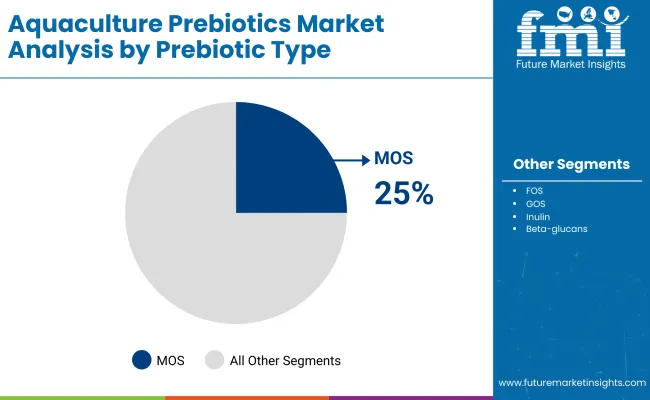
The mannan-oligosaccharides (MOS) segment is projected to account for 25.0% of the aquaculture prebiotics market in 2025, reaffirming its position as the category's dominant type. Aquaculture operators increasingly recognize the optimal balance of performance and gut health reliability offered by MOS prebiotics for most precision applications, particularly in immune system enhancement and pathogen binding processes. This type addresses both performance requirements and long-term health considerations while providing reliable protection across diverse aquaculture applications.
This type forms the foundation of most aquaculture protocols for health applications, as it represents the most widely accepted and commercially viable level of prebiotic technology in the industry. Performance standards and extensive research testing continue to strengthen confidence in MOS prebiotic formulations among farming and aquaculture providers. With increasing recognition of the performance-health optimization requirements in aquaculture management, MOS systems align with both operational efficiency and health goals, making them the central growth driver of comprehensive aquaculture nutrition strategies.
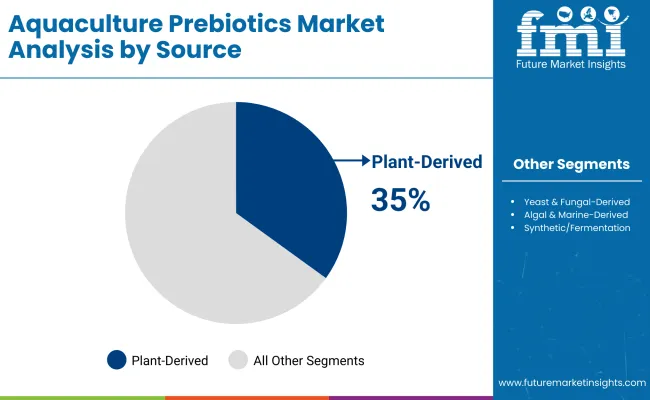
Plant-derived sources are projected to represent 35.0% of aquaculture prebiotics demand in 2025, underscoring their role as the primary source segment driving market adoption and growth. Farmers recognize that aquaculture nutrition requirements, including complex gut health operations, specialized microbiome needs, and multi-stage feeding systems, often require advanced plant-derived prebiotics that standard synthetic technologies cannot adequately provide. Plant-derived prebiotics offer enhanced biocompatibility and regulatory compliance in aquaculture nutrition applications.
The segment is supported by the growing complexity of farming operations, requiring natural ingredient systems, and the increasing recognition that plant-based technologies can improve aquaculture performance and health outcomes. Additionally, farmers are increasingly adopting evidence-based nutrition guidelines that recommend specific plant-derived prebiotics for optimal gut health efficiency. As understanding of aquaculture nutrition complexity advances and farming requirements become more stringent, plant-derived prebiotics will continue to play a crucial role in comprehensive health management strategies within the aquaculture market.
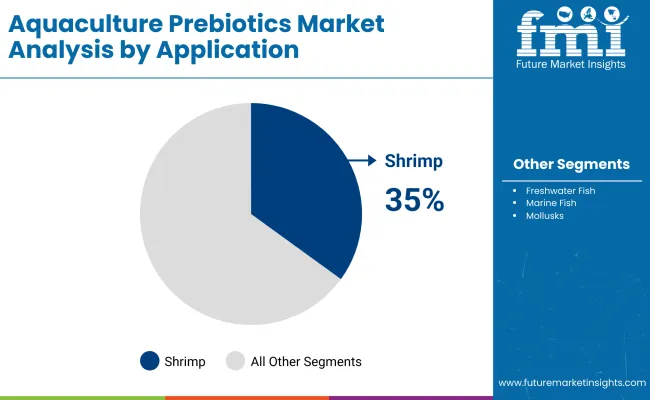
Shrimp are projected to represent 35.0% of aquaculture prebiotics demand in 2025, demonstrating their critical role as the primary application segment driving market expansion and adoption. Aquaculture operators recognize that shrimp production requirements, including complex immune system processes, specialized pathogen resistance needs, and multi-level health systems, often require advanced prebiotics that standard nutrition technologies cannot adequately provide. Shrimp-focused prebiotics offer enhanced disease prevention and growth compliance in aquaculture production applications.
The shrimp segment's dominance reflects the species' particular vulnerability to disease outbreaks and the economic impact of production losses in intensive farming systems. White spot syndrome virus, early mortality syndrome, and bacterial infections represent constant threats that drive demand for preventive nutrition solutions. Prebiotics enable shrimp farmers to maintain higher stocking densities while reducing mortality rates, particularly during critical growth phases and environmental stress periods. The segment benefits from extensive research demonstrating prebiotic efficacy in improving feed conversion ratios, enhancing molting success, and strengthening immune responses in both Penaeusvannamei and Penaeus monodon cultivation systems.
The aquaculture prebiotics market is advancing steadily due to increasing recognition of gut health technologies' importance and growing demand for high-efficiency disease prevention systems across the aquaculture and marine farming sectors. However, the market faces challenges, including complex formulation processes, potential for bioavailability variations during storage and handling, and concerns about supply chain consistency for specialized fermentation products. Innovation in biotechnology and customized aquaculture protocols continues to influence product development and market expansion patterns.
Expansion of Advanced Aquaculture Facilities and Nutrition Technologies
The growing adoption of advanced aquaculture facilities is enabling the development of more sophisticated prebiotic production and performance monitoring systems that can meet stringent operational requirements. Specialized aquaculture facilities offer comprehensive nutrition services, including advanced health monitoring and feed optimization processes that are particularly important for achieving high-efficiency requirements in production applications. Advanced aquaculture infrastructure provides access to premium services that can optimize growth performance and reduce disease incidence while maintaining cost-effectiveness for large-scale farming operations.
Integration of Precision Feeding Systems and Health Management Systems
Modern aquaculture organizations are incorporating digital technologies such as real-time performance monitoring, automated feeding systems, and farm integration to enhance prebiotic deployment and distribution processes. These technologies improve system performance, enable continuous health monitoring, and provide better coordination between farmers and aquaculture operators throughout the production cycle. Advanced digital platforms also enable customized nutrition specifications and early identification of potential health deviations or supply disruptions, supporting reliable aquaculture production.

| Countries | CAGR (2025 to 2035) |
|---|---|
| France | 6.9% |
| USA | 6.7% |
| Germany | 6.4% |
| China | 6.3% |
| India | 5.8% |
| UK | 5.3% |
| Brazil | 1.9% |
The aquaculture prebiotics market is experiencing varied growth globally, with France leading at a 6.9% CAGR through 2035, driven by the expansion of aquaculture infrastructure development, increasing farming capacity capabilities, and growing domestic demand for high-efficiency prebiotic systems. USA follows at 6.7%, supported by aquaculture expansion, growing recognition of advanced nutrition technology importance, and expanding farming capacity. Germany records 6.4% growth, with a focus on developing the aquaculture infrastructure and precision farming industries. China shows 6.3% growth, representing a major market with expanding aquaculture frameworks. India demonstrates 5.8% growth, emphasizing nutrition infrastructure expansion and systematic aquaculture approaches. UK demonstrates 5.3% growth, emphasizing aquaculture infrastructure expansion and systematic farming approaches. Brazil demonstrates 1.9% growth, representing emerging market opportunities with developing aquaculture capabilities.
Revenue from aquaculture prebiotics in France is projected to exhibit robust growth with a CAGR of 6.9% through 2035, driven by ongoing aquaculture expansion and increasing recognition of high-efficiency nutrition systems as essential health management components for complex farming processes. The country's expanding aquaculture infrastructure and growing availability of specialized nutrition capabilities are creating significant opportunities for prebiotic adoption across both domestic and export-oriented aquaculture facilities. Major international and domestic nutrition companies are establishing comprehensive production and distribution networks to serve the growing population of farmers and aquaculture facilities requiring high-performance nutrition systems throughout France's major farming regions.
The French government's strategic emphasis on aquaculture infrastructure modernization and farming advancement is driving substantial investments in specialized nutrition capabilities. Government initiatives supporting aquaculture development and nutrition modernization are driving demand for high-efficiency nutrition systems throughout major aquaculture centers, including Brittany, Normandy, and Mediterranean coastal regions. Aquaculture capacity expansion and nutrition system development are supporting appropriate utilization of prebiotics among farmers nationwide, with particular growth in marine fish production operations.
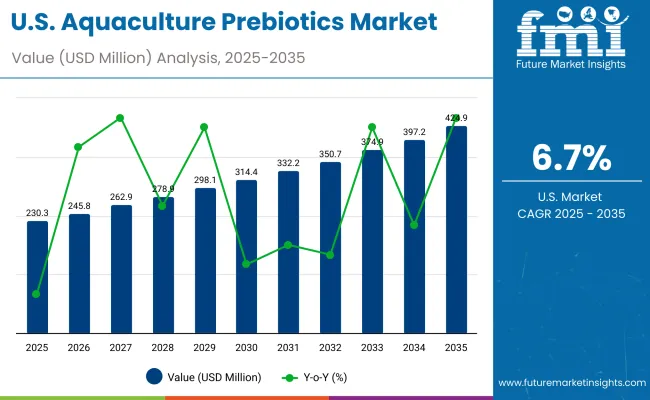
Revenue from aquaculture prebiotics in USA is expanding at a CAGR of 6.7%, supported by increasing aquaculture accessibility, growing nutrition infrastructure awareness, and developing technology market presence across the country's major farming clusters. The country's large aquaculture sector and increasing recognition of advanced nutrition systems are driving demand for effective high-efficiency health solutions in both fish production and aquaculture applications. International nutrition companies and domestic providers are establishing comprehensive distribution channels to serve the growing demand for quality nutrition systems.
USA's aquaculture sector continues to benefit from favorable nutrition policies, expanding aquaculture capabilities, and cost-competitive nutrition infrastructure development. The country's focus on becoming a global aquaculture technology hub is driving investments in specialized nutrition technology and health management infrastructure. Rising awareness about advanced nutrition options and improving aquaculture capabilities are creating opportunities for specialized nutrition systems across farming settings in major hubs like California, Washington, and Gulf Coast states.
Germany's advanced aquaculture technology market demonstrates sophisticated nutrition infrastructure deployment with documented prebiotic effectiveness in farming departments and aquaculture centers through integration with existing nutrition systems and health infrastructure. The country leverages aquaculture expertise in nutrition technology and health management systems integration to maintain a 6.4% CAGR through 2035. Aquaculture centers, including major farming areas, showcase premium installations where prebiotics integrate with comprehensive health information systems and nutrition platforms to optimize growth accuracy and operational workflow effectiveness.
German farmers prioritize system reliability and health compliance in infrastructure development, creating demand for premium systems with advanced features, including performance validation and integration with German aquaculture standards. The market benefits from established farming industry infrastructure and a willingness to invest in advanced nutrition technologies that provide long-term operational benefits and compliance with health regulations.
China's market expansion benefits from diverse aquaculture demand, including nutrition infrastructure modernization in coastal provinces, health development programs, and government aquaculture programs that increasingly incorporate prebiotic solutions for infrastructure enhancement applications. The country maintains a 6.3% CAGR through 2035, driven by rising aquaculture awareness and increasing adoption of nutrition benefits, including superior health capabilities and reduced complexity.
Market dynamics focus on cost-effective nutrition solutions that balance advanced health features with affordability considerations important to Chinese aquaculture operators. Growing aquaculture infrastructure creates demand for modern nutrition systems in new farming facilities and aquaculture equipment modernization projects. Regional aquaculture requirements are driving a diverse product portfolio from basic nutrition systems to advanced health platforms. Import dependency challenges offset by potential local development partnerships with international nutrition manufacturers.
India demonstrates growing market development with a 5.8% CAGR through 2035, driven by expanding aquaculture infrastructure and increasing adoption of nutrition technologies across the country's major farming regions. The market benefits from government initiatives supporting aquaculture development and growing recognition of advanced nutrition systems as essential components for modern farming operations. Market expansion is supported by rising domestic demand for high-quality fish products and increasing focus on export-oriented aquaculture facilities.
Growing aquaculture infrastructure creates opportunities for modern nutrition systems in new farming facilities and equipment modernization projects. Regional aquaculture requirements are driving demand for cost-effective nutrition solutions that can improve production efficiency while maintaining affordability for local farming operations. Government support for Blue Revolution initiatives and aquaculture development programs are creating favorable conditions for prebiotic adoption.
UK's market expansion demonstrates steady growth with a 5.3% CAGR through 2035, driven by advanced aquaculture infrastructure and established farming operations focusing on high-quality nutrition systems. The country's sophisticated aquaculture sector emphasizes technical excellence and regulatory compliance, creating demand for premium prebiotic solutions that meet stringent performance standards. Market development is supported by strong research institutions, established supply chains, and focus on export-oriented aquaculture operations.
British aquaculture operators prioritize system reliability and performance validation, driving demand for proven nutrition technologies with comprehensive technical support. The market benefits from established relationships between feed manufacturers and aquaculture producers, enabling rapid adoption of innovative prebiotic formulations. Scotland's salmon farming industry represents a significant portion of demand, requiring advanced nutrition solutions for intensive production systems.
Brazil demonstrates emerging market development with a 1.9% CAGR through 2035, representing opportunities for market expansion in Latin American aquaculture operations. The country's market development is influenced by growing recognition of nutrition technologies' importance and expanding aquaculture infrastructure in both coastal and inland regions. Market dynamics focus on cost-effective solutions that balance performance requirements with economic considerations important to Brazilian aquaculture operators.
Growing tilapia and shrimp farming operations create demand for affordable nutrition systems that can improve production efficiency while maintaining economic viability. Regional aquaculture development programs and government support for aquaculture modernization are beginning to influence adoption of advanced nutrition technologies. The market faces challenges from economic constraints but benefits from expanding domestic protein demand and export potential.
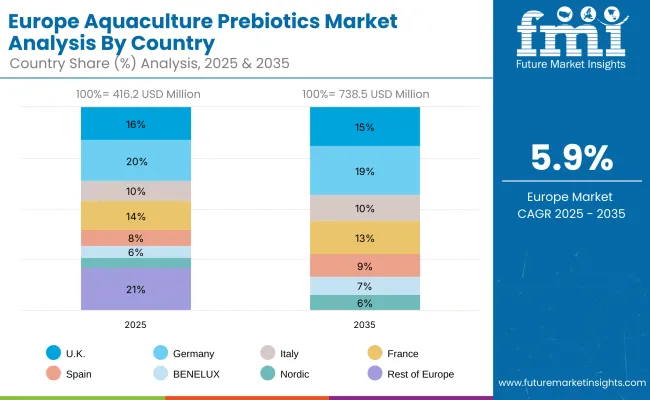
The aquaculture prebiotics market in Europe is projected to grow significantly, with individual country performance varying across the region. Germany is expected to maintain its leadership position with a market value of USD 83.2 million in 2025, supported by its advanced aquaculture infrastructure, precision nutrition capabilities, and strong farming presence throughout major aquaculture regions.
France follows with USD 58.2 million in 2025, driven by advanced nutrition protocols, aquaculture innovation integration, and expanding farming networks serving both domestic and international markets. UK holds USD 66.6 million in 2025, supported by aquaculture infrastructure expansion and growing adoption of high-efficiency nutrition systems. Italy commands USD 41.6 million in 2025, while Spain accounts for USD 33.3 million in 2025. The Rest of Europe region, including Nordic countries, Eastern Europe, and smaller Western European markets, holds USD 87.4 million in 2025, representing diverse market opportunities with established aquaculture and nutrition infrastructure capabilities.

The aquaculture prebiotics market is characterized by competition among established feed companies, specialty nutrition companies, and biotechnology suppliers focused on delivering high-efficiency, consistent, and reliable prebiotic systems. Companies are investing in fermentation technology advancement, performance enhancement, strategic partnerships, and customer technical support to deliver effective, efficient, and reliable nutrition solutions that meet stringent farming and aquaculture requirements. Health optimization, performance validation protocols, and supply chain strategies are central to strengthening product portfolios and market presence.
Alltech Inc. leads the market with an 18.0% market share, leveraging extensive fermentation expertise and global aquaculture presence to deliver comprehensive prebiotic solutions across multiple species applications. The company's strength lies in proprietary yeast-based technologies and integrated nutrition approaches encompassing prebiotics, probiotics, and functional feed additives.
Nutreco N.V. operates through its Skretting brand, offering high-efficiency prebiotics with focus on performance consistency for salmon, shrimp, and marine fish segments. Cargill Aqua Nutrition provides specialized systems emphasizing large-scale operations and technical support services. ADM focuses on advanced fermentation technologies and customized solutions for global markets. Evonik Industries delivers established systems with strong performance capabilities through its animal nutrition division.
IFF/DuPont operates through Danisco Animal Nutrition, combining fermentation expertise with advanced encapsulation technologies. Biomin specializes in natural growth promotion and integrated health management approaches. Other significant players include Ridley Aqua Feed, BioMar Group, Kemin Industries, Olmix Group, Angel Yeast Co., ICC Brazil, Blue Aqua International, and Jefo Nutrition, each focusing on specific market segments or regional strengths.
| Items | Values |
|---|---|
| Quantitative Units (2025) | USD 1,234.2 Million |
| Prebiotic Type | MOS, FOS, GOS, Inulin, Beta-glucans, Resistant Starch & Fibers, Novel Prebiotics |
| Source | Plant-derived, Yeast & Fungal-derived, Algal & Marine-derived, Synthetic/Fermentation-derived |
| Application | Shrimp, Freshwater Fish, Marine Fish, Mollusks , Others |
| Form | Powder / Dry Blends, Liquid Additives, Encapsulated / Coated Forms, Prebiotic-rich Functional Feed |
| Functionality | Gut Health & Microbiome Balance, Growth Performance & Feed Conversion, Immunity Enhancement & Disease Resistance, Stress Tolerance (salinity, crowding, transport) |
| Distribution Channel | Direct to Feed Mills & Integrators, Distributors / Wholesalers, Online & Specialized Aquaculture Suppliers |
| Regions Covered | North America, Europe, East Asia, South Asia & Pacific, Latin America, Middle East & Africa |
| Countries Covered | China, USA, Germany, Japan, India, South Korea, France and 40+ countries |
| Key Companies Profiled | Nutreco N.V., Cargill Aqua Nutrition, ADM, Evonik Industries, IFF/DuPont, Alltech Inc., Biomin , and Ridley Aqua Feed |
| Additional Attributes | Dollar sales by type and application, regional demand trends, competitive landscape, farming provider preferences for specific nutrition systems, integration with specialty aquaculture supply chains, innovations in fermentation technologies, performance monitoring, and health optimization |
The global aquaculture prebiotics market is estimated to be valued at USD 1,234.2 million in 2025.
The market size for the aquaculture prebiotics market is projected to reach USD 2,220.1 million by 2035.
The aquaculture prebiotics market is expected to grow at a 6.0% CAGR between 2025 and 2035.
The key prebiotic types in the aquaculture prebiotics market include mannan-oligosaccharides (MOS), fructo-oligosaccharides (FOS), galacto-oligosaccharides (GOS), inulin, beta-glucans, and resistant starch & fibers.
In terms of prebiotic type, the MOS segment is expected to command 25.0% share in the aquaculture prebiotics market in 2025.






Our Research Products

The "Full Research Suite" delivers actionable market intel, deep dives on markets or technologies, so clients act faster, cut risk, and unlock growth.

The Leaderboard benchmarks and ranks top vendors, classifying them as Established Leaders, Leading Challengers, or Disruptors & Challengers.

Locates where complements amplify value and substitutes erode it, forecasting net impact by horizon

We deliver granular, decision-grade intel: market sizing, 5-year forecasts, pricing, adoption, usage, revenue, and operational KPIs—plus competitor tracking, regulation, and value chains—across 60 countries broadly.

Spot the shifts before they hit your P&L. We track inflection points, adoption curves, pricing moves, and ecosystem plays to show where demand is heading, why it is changing, and what to do next across high-growth markets and disruptive tech

Real-time reads of user behavior. We track shifting priorities, perceptions of today’s and next-gen services, and provider experience, then pace how fast tech moves from trial to adoption, blending buyer, consumer, and channel inputs with social signals (#WhySwitch, #UX).

Partner with our analyst team to build a custom report designed around your business priorities. From analysing market trends to assessing competitors or crafting bespoke datasets, we tailor insights to your needs.
Supplier Intelligence
Discovery & Profiling
Capacity & Footprint
Performance & Risk
Compliance & Governance
Commercial Readiness
Who Supplies Whom
Scorecards & Shortlists
Playbooks & Docs
Category Intelligence
Definition & Scope
Demand & Use Cases
Cost Drivers
Market Structure
Supply Chain Map
Trade & Policy
Operating Norms
Deliverables
Buyer Intelligence
Account Basics
Spend & Scope
Procurement Model
Vendor Requirements
Terms & Policies
Entry Strategy
Pain Points & Triggers
Outputs
Pricing Analysis
Benchmarks
Trends
Should-Cost
Indexation
Landed Cost
Commercial Terms
Deliverables
Brand Analysis
Positioning & Value Prop
Share & Presence
Customer Evidence
Go-to-Market
Digital & Reputation
Compliance & Trust
KPIs & Gaps
Outputs
Full Research Suite comprises of:
Market outlook & trends analysis
Interviews & case studies
Strategic recommendations
Vendor profiles & capabilities analysis
5-year forecasts
8 regions and 60+ country-level data splits
Market segment data splits
12 months of continuous data updates
DELIVERED AS:
PDF EXCEL ONLINE
Aquaculture Equipment Market Size and Share Forecast Outlook 2025 to 2035
Aquaculture Therapeutics Market Size and Share Forecast Outlook 2025 to 2035
Aquaculture Vaccines Market Analysis - Size, Share, and Forecast Outlook for 2025 to 2035
Aquaculture Market – Growth, Demand & Sustainable Practices
Global Aquaculture Immunostimulants Market Analysis – Size, Share & Forecast 2024-2034
Chile Aquaculture Vaccines Market Insights – Size, Demand & Forecast 2025-2035
China Aquaculture Vaccines Market Outlook – Growth & Forecast 2025-2035
Norway Aquaculture Vaccines Market Insights – Size, Demand & Growth 2025-2035
Vietnam Aquaculture Vaccines Market Trends – Growth & Demand 2025-2035
Precision Aquaculture Market Size and Share Forecast Outlook 2025 to 2035
Bacterial Diagnostics in Aquaculture Market Insights - Growth & Forecast 2025 to 2035
Australia and New Zealand Aquaculture Vaccines Market Report – Key Trends & Forecast 2025-2035
Pet Prebiotics Market Analysis - Size, Growth, and Forecast 2025 to 2035
Marine Prebiotics Market Size and Share Forecast Outlook 2025 to 2035
Animal Feed Prebiotics Market – Growth, Livestock Nutrition & Demand

Thank you!
You will receive an email from our Business Development Manager. Please be sure to check your SPAM/JUNK folder too.
Chat With
MaRIA